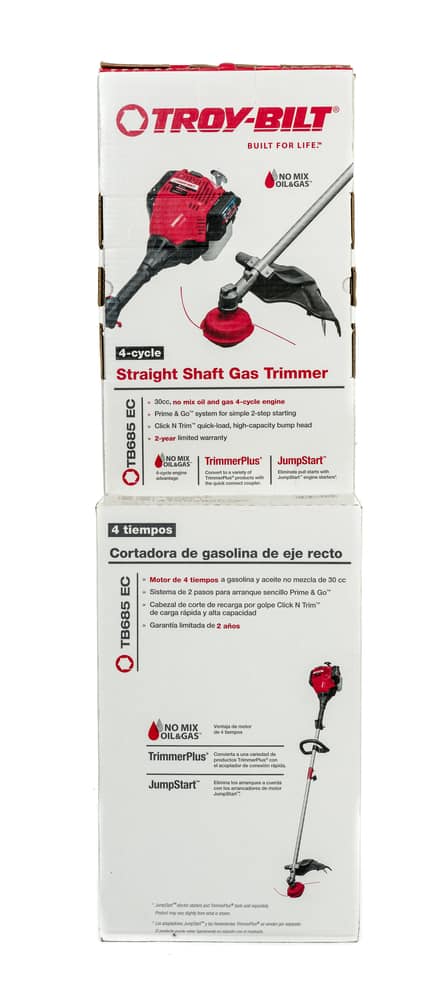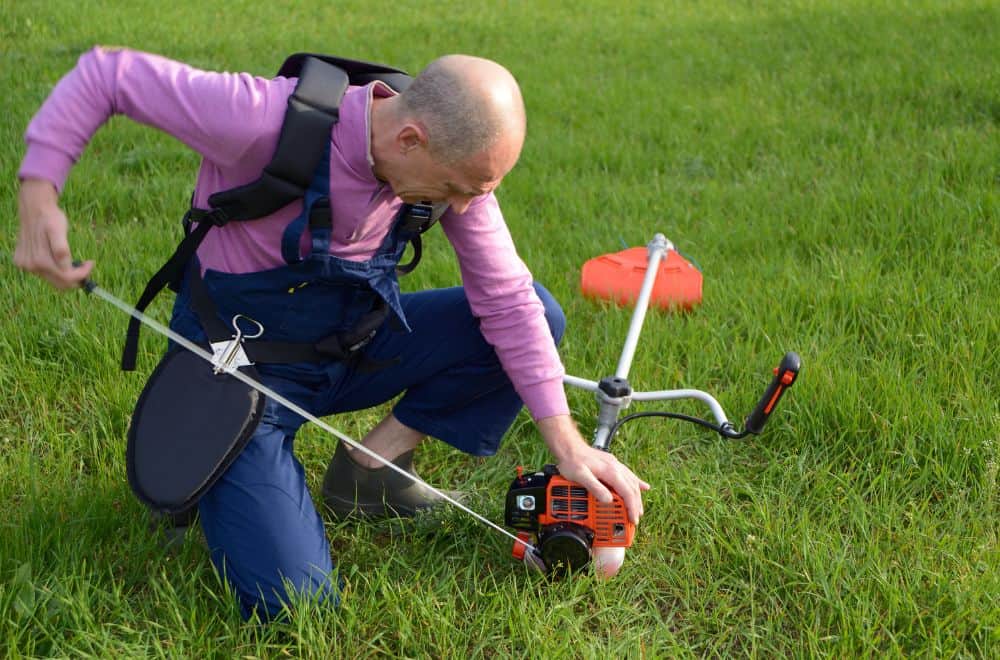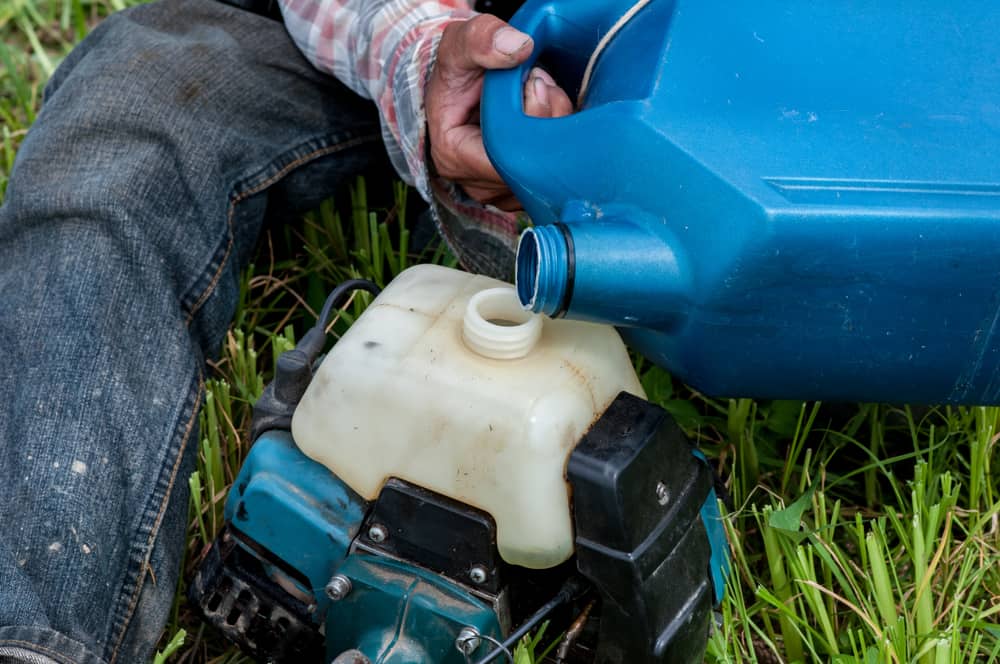Before using your weed eater, you need to prepare it. This procedure includes mixing fuel properly because an inadequate amount of oil can overheat the engine (if the amount is to low) or cause engine congestion (if the amount is too high).
Therefore, it is essential to calculate the correct gas/oil ratio and ensure the smooth work of this useful garden tool.
Read a user guide

At first, before starting mixing fuel for your weed eater, you need to read the user guide. Since it is the manufacturers’ obligation to enclose the manual along with the product they sell, you will find it in the package.
Always keep in mind that you should check for additional information even though there is a general recommendation about the proper oil to gas ratio for this type of devices. Sometimes there are slight differences regarding the type of fuel and gas/oil mixture which is ideal for the model you have.
Check the container

The next step is to check if the gas container is a good match for your engine. This part is crucial since you need to use the approved one. Believe me; you want to pick out the container for containing gasoline which is specially designed for the particular weed eater.
For example, I highly recommend you choosing the No-Spill fuel container. Its specific design will make the engine more reliable and decrease spillage and evaporation as well as reduce permeation.
Consider gas type

There are a few types of gas you can use for your gas weed eater, but don’t forget to check the one typical for the model you have. Also, avoid cheap gas since it can be fatal for the engine in the long run.
Some people prefer going premium but, in general, mid-grade unleaded gas is usually the stuff of choice. Since you will mix it with oil, the lowest recommended octane rating for gasoline you should use is definitely 89.
The reason for this choice is the fact that fuel with a lower octane rating will probably increase the temperature of your unit’s engine too much. The elevated engine temperature will cause piston failure and consequently possible damage to the engine.
Also, avoid diesel fuel. In some situations, you can use gasoline blended with a maximum of 10% alcohol, but be prepared that alcohol will decrease the power of your unit’s engine, and it will probably start running unpredictably.
If you one of those people who prefer alternative fuels (ethanol or methanol), you can do it. I have just one warning. When you pick out this type of fuel, avoid storing your weed eater with a full gas tank for a long time. This mixture will form acids over time when the level of humidity in the environment is high. As a result, you will get damaged fuel system.
Consider oil type of weed eater
In general, you can use the most oil types offered on the market. However, if you prefer the best, you should consider premium quality two-cycle oils. This oil is specifically designed to allow your engine works smoothly. Plus, this oil will protect it at the same time.
Proper oil to gas ratio for weed eater

Which fuel/oil mix ratio is correct for your weed eater depends on the model you have. If you are not sure which ratio fits your machine, you should check the fuel tank or the gas cap. Most manufacturers stamp the recommended fuel/oil ratio for each particular weed eater there. If you can’t find it, look for that data in the owner’s manual.
There are three possible ratios (32:1, 40:1, and 50:1). Determining the right one for your unit is a crucial thing. If you use the wrong ratio, you are at risk of harming the engine.
Basically, it is not too hard to calculate it. The most common fuel/oil mix ratio is 40:1. That means that you need 40 parts of gas to one gallon of oil. The same rule applies to the other two mixtures.
If you know that one gallon of oil is equal to 128 oz. (1 US gallon), you just need to divide 128 oz. with the recommended mix ratio and you will calculate how many ounces of oil you need. It can be:
1 – 128/32 = 4 oz. of oil
That means you will need 4 ounces of oil when the recommended ratio is 32:1.
2 – 128/40 = 3.2 oz. of oil
That means you will need 3.2 ounces of oil when the recommended ratio is 40:1.
3 – 128/50 = 2.6 oz. of oil
That means you will need 2.6 ounces of oil when the recommended ratio is 50:1.
You can make the calculation for liters as well, or just look at the table I enclosed bellow.
| Gas/oil ratio | Volume of gas | Volume of oil | Gas/oil ratio | Volume of gas | Volume of oil |
| 32:1 | 128 oz.* | 4 oz. | 32:1 | 1 l | 31.25 ml |
| 40:1 | 128 oz. | 3.2 oz. | 40:1 | 1 l | 25 ml |
| 50:1 | 128 oz. | 2.6 oz. | 50:1 | 1 l | 20 ml |
*128 oz = 1 US gallon
As I already mentioned, always choose at least 89 octane’s gas with a maximum of 10% alcohol and oil adequate for two-cycle engines. Since automobile motor oil contains non-combustible additives which can damage the engine of the weed eater, you should avoid using it.
To mix gas and oil properly, pour oil into the fuel canister first. Then add the recommended amount of gas. After closing the canister, shake it to ensure that gas and oil are mixed correctly. Be careful while doing it. I am pretty sure that you don’t want to have the mixture all over the place.
Clean the fuel cap
After preparing your gas/oil mixture, you need to clean up the fuel cap and the surrounding area by using а shop towel. That way, you will prevent any debris from falling into the engine’s gas container. Then pour the mix into it.
Keep gas fresh
Always keep in mind that the gas/oil mixture doesn’t have a long shelf life. Therefore, make only the amount of fuel you need for a few days. Take care to shake the canister before use the mixture every single time.

Leave a comment